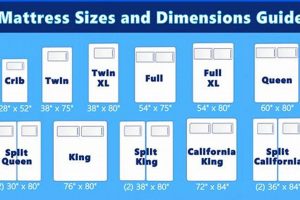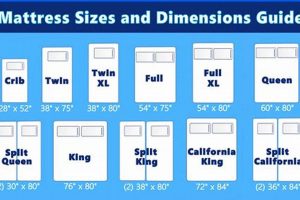Mattress dimensions across Europe vary significantly from those commonly found in North America. These measurements, often expressed in centimeters, reflect differing standards and preferences regarding sleeping arrangements. For instance, a standard single bed in certain European countries may measure 90cm x 200cm, while a double bed might be 140cm x 200cm. These dimensions are crucial when sourcing bedding or designing bedroom spaces for European consumers.
Understanding the nuanced range of bed dimensions is essential for manufacturers, retailers, and individuals seeking to furnish homes with appropriate bedding. Ignoring these discrepancies can lead to ill-fitting sheets, uncomfortable sleep experiences, and ultimately, dissatisfied customers. Historically, regional differences in building construction and room sizes have influenced the development of these unique measurements, further highlighting their cultural significance.
The following discussion will delve into the specific measurements common throughout Europe, exploring regional variations and offering guidance for navigating this diverse landscape. This will encompass single, double, king, and super-king dimensions, providing a comprehensive overview of available options. Careful consideration of these details is vital for ensuring optimal comfort and satisfaction.
Selecting the appropriate mattress requires careful consideration of size and regional standards. Misunderstanding these measurements can lead to compatibility issues and discomfort. These insights offer guidance for informed decision-making.
Tip 1: Research Regional Standards: European countries often have unique mattress dimensions. Prior to purchase, confirm the specific standards applicable in the relevant region.
Tip 2: Measure Bedroom Space: Accurately measure the available bedroom space. Ensure that the chosen mattress size allows for comfortable movement and does not overcrowd the room.
Tip 3: Consider Sleeper Needs: Take into account the number of sleepers and their individual space requirements. Larger individuals or couples may benefit from king or super-king size mattresses.
Tip 4: Verify Bedding Compatibility: Confirm that readily available bedding, such as sheets and duvet covers, matches the chosen mattress measurements. Avoid relying on assumptions regarding standard sizes.
Tip 5: Check Frame Dimensions: Ensure that the bed frame is compatible with the selected mattress size. An ill-fitting frame can compromise support and reduce the mattress’ lifespan.
Tip 6: Understand Metric Conversions: Familiarize oneself with metric to imperial conversions. European mattress dimensions are typically expressed in centimeters, requiring conversion for those accustomed to inches.
These tips underscore the importance of meticulous planning when choosing a mattress. Accurate measurements and an understanding of regional variations are crucial for a satisfactory outcome.
The subsequent sections will explore common challenges encountered when purchasing from international sources and strategies for mitigating potential problems.
1. Centimeters vs. Inches
The distinction between metric (centimeters) and imperial (inches) units of measurement constitutes a fundamental consideration when procuring mattresses originating from or intended for use in Europe. Discrepancies arising from unit conversion errors can lead to significant compatibility issues and render a mattress unsuitable for its intended bed frame or bedding.
- Dimensional Disparity
The core issue resides in the numerical difference between equivalent measurements. One inch equates to precisely 2.54 centimeters. Consequently, a mattress described as 150cm wide differs substantially from one specified as 60 inches wide (which translates to 152.4 cm). This seemingly minor variation can impact fit and comfort.
- Bed Frame Incompatibility
Bed frames are typically manufactured to accommodate mattresses of specific dimensions. An incorrect unit conversion may result in the purchase of a mattress that either exceeds or falls short of the frame’s internal measurements. The consequence is either an inability to properly support the mattress or a lack of stability and potential for movement within the frame.
- Bedding Procurement Challenges
Sheets, duvet covers, and other bedding accessories are designed for mattresses of precise sizes. Mismatched units can lead to bedding that is either too tight, causing undue stress on the fabric and potential tearing, or too loose, resulting in an unkempt appearance and diminished comfort. Precise measurements are thus critical for aesthetic and functional purposes.
- International Sourcing Complexities
When ordering mattresses from European manufacturers or retailers, the stated dimensions are invariably in centimeters. Purchasers accustomed to the imperial system must exercise diligence in converting these measurements to ensure compatibility with their existing bed frames and bedding. Neglecting this step carries a significant risk of incurring returns, exchanges, or the inconvenience of custom-made solutions.
Accurate conversion between centimeters and inches is non-negotiable when considering mattress dimensions in the European context. Failure to account for these differences can lead to practical and financial ramifications, underscoring the importance of meticulous measurement and diligent verification before finalizing a purchase.
2. Single Bed Variations
Variations in single bed dimensions represent a significant facet of mattress dimensions across Europe. Unlike a standardized global definition, the term encompasses a spectrum of sizes influenced by national preferences, historical precedents, and manufacturing standards. These variations manifest primarily in length and width, creating compatibility challenges for consumers seeking replacements or coordinating bedding. For example, a single bed procured in Germany, commonly measuring 90cm x 200cm, may not seamlessly fit within a bed frame or accommodate bedding designed for a UK single bed, which typically adheres to dimensions of 90cm x 190cm. The practical consequence is the potential need for custom-sized bedding or frame modifications, adding cost and complexity to the purchasing process.
The existence of differing single bed sizes directly affects retailers and manufacturers operating within the European market. Inventory management becomes more complex, requiring the stocking of various sizes to cater to regional demands. Manufacturers must adapt production lines to accommodate different dimensional standards, increasing overheads and potentially impacting pricing. Furthermore, the lack of a unified standard necessitates clear and accurate product labeling, minimizing consumer confusion and facilitating informed purchasing decisions. Failure to address these variations can result in returns, negative customer feedback, and ultimately, reduced market share.
In summary, the multiplicity of single bed sizes within the wider context of European mattress dimensions underscores the importance of detailed specification and careful measurement. The absence of a universally accepted standard necessitates vigilance on the part of both consumers and businesses. Accurately identifying the specific dimensional requirements for a particular location or market is essential for ensuring compatibility and avoiding unnecessary expenses. Therefore, understanding these nuances is not merely an academic exercise, but a practical necessity for navigating the European bedding market effectively.
3. Double Bed Dimensions
Within the framework of dimensions across Europe, the term “double bed” does not represent a universally consistent measurement. Discrepancies in width and length necessitate careful consideration to ensure compatibility and comfort.
- Width Variations Across Countries
One notable element is the divergence in width. In some regions, a double bed may measure 140cm wide, whereas in others, the standard width is 135cm. This seemingly minor difference can significantly impact sleeping comfort, especially for couples. Choosing bedding without accounting for this variation may result in improper fit and reduced user satisfaction. Bedding manufacturers must also consider these regional width preferences.
- Length Inconsistencies
Length disparities also exist. While a 200cm length is common, some countries may favor 190cm. This difference primarily affects taller individuals, potentially causing discomfort if legs extend beyond the mattress edge. When selecting a mattress, taller individuals must verify the length dimension matches their height requirements to ensure adequate support and a comfortable sleeping experience.
- Frame Compatibility Issues
The variability in mattress dimensions affects frame compatibility. A frame designed for a 140cm x 200cm mattress will not properly accommodate a 135cm x 190cm mattress. This can lead to instability, reduced support, and potential damage to the mattress or frame. Precise measurements of both the mattress and frame are essential before purchase to avoid these issues.
- Impact on Bedding Selection
These dimensional nuances extend to bedding selection. Standard double bed sheets and duvet covers may not fit mattresses of varying sizes. Ill-fitting bedding can lead to discomfort, difficulty in making the bed, and premature wear and tear. Accurate measurements are critical when purchasing bedding to ensure a proper fit and maintain aesthetic appeal.
The diversity in double bed dimensions highlights the need for precise specifications when sourcing mattresses and bedding within Europe. Retailers and consumers must prioritize accurate measurements and regional standards to avoid compatibility issues and ensure optimal comfort. This is crucial to navigate the nuanced context of bedding choices effectively.
4. King Size Differences
The specific dimensions associated with a “king size” bed exhibit considerable variation across the European landscape, forming a crucial aspect of “european mattress sizes.” The dimensions marketed as “king size” in one country may not align with those in another. This discrepancy presents challenges for consumers, manufacturers, and retailers involved in cross-border transactions. For example, a king-size bed in the United Kingdom typically measures 150cm x 200cm, while a similar designation in Scandinavia could denote dimensions closer to 180cm x 200cm. This size difference, though seemingly minor, necessitates meticulous attention to detail when sourcing bedding or constructing bed frames, impacting both cost and consumer satisfaction. These differences stem from historical factors and localized preferences influencing manufacturing standards and consumer expectations.
A practical consequence of these dimensional disparities manifests when consumers purchase mattresses or bedding online from retailers based in different European countries. Without a clear understanding of the specific dimensions, a consumer may inadvertently acquire a mattress or bedding set that is incompatible with their existing bed frame or bedroom space. This necessitates costly returns, exchanges, or, in some instances, the custom tailoring of bedding, adding unexpected expenses to the initial purchase. Furthermore, manufacturers face logistical complexities in managing inventory and production runs tailored to specific regional king-size standards, influencing supply chain efficiency.
Therefore, acknowledging and understanding the nuances of king-size bed dimensions is critical within the overall context of “european mattress sizes.” Clear communication regarding exact measurements, expressed in both centimeters and inches, helps to mitigate confusion and facilitates informed purchasing decisions. Greater standardization or clearer labeling practices are needed to ensure compatibility. Failure to address these differences ultimately increases transactional friction and reduces overall consumer satisfaction within the European bedding market.
5. Super King Expanse
The “Super King Expanse” represents the largest readily available mattress size within the European context. Its considerable dimensions are a significant consideration within the broader framework of “european mattress sizes,” impacting manufacturing, retail, and consumer choices. The increased surface area offers enhanced comfort and spaciousness, but also introduces logistical and practical challenges.
- Dimensional Variance Across Regions
Even within the “Super King Expanse” category, dimensional variations exist across European nations. While a common measurement is 180cm x 200cm, some regions may offer variations exceeding 200cm in width or length. This variance affects bed frame compatibility and bedding selection, necessitating careful measurement and adherence to regional standards. Consumers must verify dimensions before purchase to avoid incompatibility issues.
- Increased Material Requirements and Costs
The “Super King Expanse” necessitates a greater quantity of raw materials in its production compared to smaller sizes. This increased material demand directly translates to higher manufacturing costs. These costs are subsequently passed on to the consumer, making “Super King” mattresses a premium option. Retail pricing reflects these increased material requirements, placing “Super King” mattresses at the higher end of the price spectrum within the “european mattress sizes” market.
- Logistical and Transportation Challenges
The sheer size of “Super King” mattresses presents logistical and transportation challenges. Their bulk makes handling more difficult, increasing the potential for damage during transit. Retailers must factor in increased storage space requirements. Delivery to consumers’ homes can also be problematic, particularly in older buildings with narrow staircases or doorways. These logistical considerations add complexity to the supply chain and potentially increase delivery costs.
- Implications for Bedroom Space and Design
The “Super King Expanse” demands a larger bedroom to accommodate its substantial footprint. Careful consideration must be given to room dimensions to ensure sufficient space for movement and other furniture. The mattress’s size can also impact bedroom aesthetics, potentially dominating the space. Interior design choices must account for the mattress’s presence to maintain a balanced and harmonious environment. Therefore understanding mattress expanse and their effects is important to know.
The discussed aspects of “Super King Expanse” illustrate its integral role in shaping the European mattress market. Understanding dimensional variance, cost factors, logistical hurdles, and spatial implications provides a comprehensive view of the “european mattress sizes” framework. These elements collectively influence consumer decisions and business strategies within the bedding industry.
6. Regional Discrepancies
The concept of “Regional Discrepancies” constitutes a fundamental element in understanding the complexities of “european mattress sizes.” Varied historical influences, cultural preferences, and distinct manufacturing standards across European nations contribute to a fragmented market, characterized by a lack of universal standardization. This regional fragmentation significantly impacts consumers, retailers, and manufacturers, necessitating careful navigation and precise product specifications.
- Historical Influences on Sizing
Historical construction practices and the dimensions of traditional homes across different European regions have played a significant role in shaping current mattress sizes. Older buildings, prevalent in certain countries, often feature smaller bedrooms, thus influencing the demand for correspondingly smaller mattresses. Conversely, newer constructions may accommodate larger mattress dimensions. This historical context underscores the persistence of localized sizing preferences and manufacturing traditions.
- Cultural Preferences in Sleep Arrangements
Cultural norms regarding sleep arrangements also contribute to “european mattress sizes” fragmentation. For instance, in some cultures, it is common for couples to prefer separate single mattresses rather than a single double or king-size mattress. This preference affects the demand for specific sizes and impacts manufacturers’ production strategies. Market research, sensitive to cultural nuances, is crucial for effectively catering to diverse regional demands.
- Manufacturing Standards and Metrology
Variations in manufacturing standards and metrological practices across different European countries further exacerbate the “Regional Discrepancies” problem. Differing interpretations of size tolerances and measurement protocols can lead to subtle but significant variations in the actual dimensions of mattresses marketed as the same size. This inconsistency poses challenges for consumers attempting to match mattresses with existing bed frames or bedding purchased from different sources.
- Impact on Cross-Border Trade and E-commerce
The lack of standardization poses considerable challenges for cross-border trade and e-commerce within the European mattress market. Retailers selling mattresses online must provide extremely detailed size specifications, often in both centimeters and inches, to minimize the risk of returns due to incompatibility. Consumers, in turn, must exercise due diligence in verifying dimensions before making a purchase. The absence of uniform standards increases transactional friction and necessitates clear communication to bridge the gap between diverse regional practices.
These multifaceted “Regional Discrepancies,” encompassing historical influences, cultural preferences, manufacturing standards, and their impact on trade, collectively underscore the fragmented nature of “european mattress sizes.” Addressing these discrepancies requires greater transparency in product labeling, adherence to clear measurement protocols, and heightened consumer awareness. Ultimately, a deeper understanding of these regional nuances is essential for navigating the complexities of the European mattress market and ensuring consumer satisfaction.
Frequently Asked Questions
The following section addresses common inquiries and clarifies potential points of confusion regarding mattress dimensions within Europe.
Question 1: Are mattress dimensions standardized across all European countries?
No. Significant variations exist due to historical factors, regional preferences, and differing manufacturing standards. What constitutes a “double” or “king” size can vary considerably from country to country.
Question 2: What unit of measurement is primarily used for mattress dimensions in Europe?
Mattress dimensions are predominantly expressed in centimeters (cm). However, some retailers may also provide measurements in inches (in) for consumer convenience. Precise conversion is crucial when comparing sizes.
Question 3: How do I ensure compatibility between a European mattress and a bed frame purchased elsewhere?
Meticulous measurement of both the mattress and bed frame is essential. Confirm that the internal dimensions of the frame precisely match the external dimensions of the mattress, accounting for any tolerances. Consider consulting with a bedding specialist for guidance.
Question 4: What are the common dimensions for a single mattress in Europe?
While not universally consistent, a typical single mattress measures approximately 90cm x 200cm. However, variations, such as 90cm x 190cm, are prevalent in certain regions. Always verify the specific dimensions before purchase.
Question 5: Are bedding sizes universally compatible with European mattress dimensions?
No. Bedding sizes often vary to correspond with regional mattress dimensions. Purchasing bedding specifically designed for the mattress dimensions in question is essential to ensure a proper fit and avoid discomfort.
Question 6: What are the potential consequences of ignoring dimensional discrepancies when purchasing mattresses?
Ignoring dimensional discrepancies can result in ill-fitting mattresses, compromised support, increased wear and tear, and overall discomfort. Returns, exchanges, or the need for custom-made solutions may also arise, adding to the expense and inconvenience.
Understanding these nuances is paramount for a successful mattress purchase.
The subsequent section will delve into resources for locating reliable information.
European Mattress Sizes
The preceding discussion has comprehensively explored “european mattress sizes,” emphasizing the critical importance of understanding regional variations, dimensional discrepancies, and the implications for consumers and businesses. The analysis has highlighted the lack of a unified standard across Europe, underscoring the need for meticulous attention to detail in purchasing and manufacturing processes. Furthermore, the document has addressed the historical, cultural, and logistical factors contributing to this complex landscape.
Continued awareness and adherence to precise measurement protocols are essential for navigating the European bedding market effectively. Stakeholders should prioritize transparent communication regarding product specifications and strive for increased standardization to mitigate confusion and ensure consumer satisfaction. Careful consideration of these elements remains paramount for fostering a more efficient and reliable market ecosystem and driving enhanced product outcomes.


![Best Intex Queen Size Inflatable Mattress [Guide 2024] Organic & Natural Mattress Buyer’s Guide: Non-Toxic Sleep Solutions Best Intex Queen Size Inflatable Mattress [Guide 2024] | Organic & Natural Mattress Buyer’s Guide: Non-Toxic Sleep Solutions](https://mattressworldpa.com/wp-content/uploads/2025/07/th-2231-300x200.jpg)




